Investigating Air Recirculation Through a Duct-Room System: Report
VerifiedAdded on 2023/06/04
|14
|3203
|480
Report
AI Summary
This lab report details an experiment examining air flow within a duct-room system, focusing on heat losses during heating and cooling processes, and the power consumption of pre-heaters. Two tests were conducted: Test A, involving direct air flow through the duct and outlet, and Test B, using a recirculated system. The report outlines the methodology, including equipment used (velocity meters, temperature sensors, fan, pre-heaters, and recirculation duct) and experimental setup. Assumptions made during the experiment are listed, and the procedure for both Test A and Test B are described. The results and analysis section presents calculations for heat loss and power consumption, followed by a conclusion summarizing the findings. Desklib provides access to similar reports and solved assignments for students.
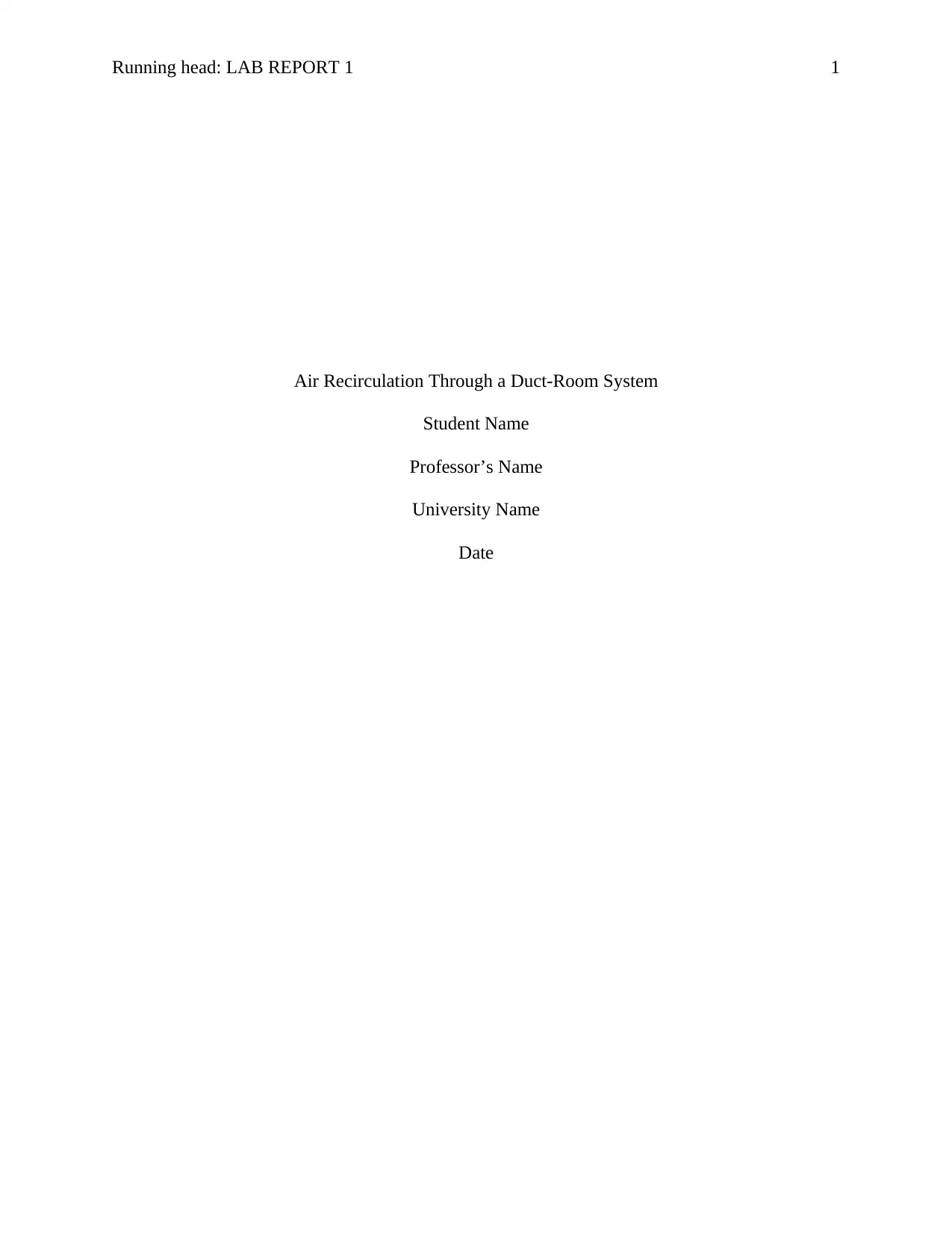
Running head: LAB REPORT 1 1
Air Recirculation Through a Duct-Room System
Student Name
Professor’s Name
University Name
Date
Air Recirculation Through a Duct-Room System
Student Name
Professor’s Name
University Name
Date
Paraphrase This Document
Need a fresh take? Get an instant paraphrase of this document with our AI Paraphraser
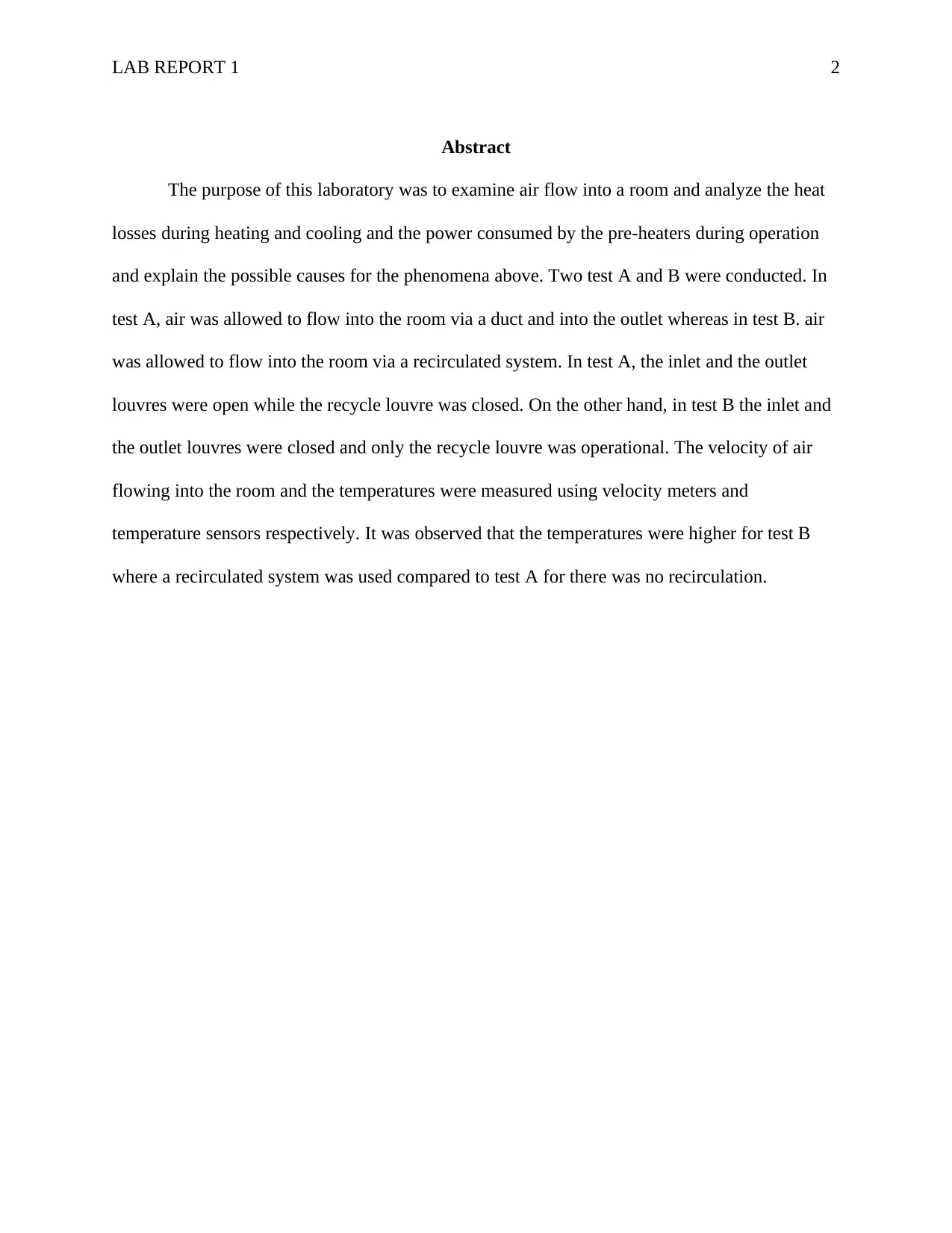
LAB REPORT 1 2
Abstract
The purpose of this laboratory was to examine air flow into a room and analyze the heat
losses during heating and cooling and the power consumed by the pre-heaters during operation
and explain the possible causes for the phenomena above. Two test A and B were conducted. In
test A, air was allowed to flow into the room via a duct and into the outlet whereas in test B. air
was allowed to flow into the room via a recirculated system. In test A, the inlet and the outlet
louvres were open while the recycle louvre was closed. On the other hand, in test B the inlet and
the outlet louvres were closed and only the recycle louvre was operational. The velocity of air
flowing into the room and the temperatures were measured using velocity meters and
temperature sensors respectively. It was observed that the temperatures were higher for test B
where a recirculated system was used compared to test A for there was no recirculation.
Abstract
The purpose of this laboratory was to examine air flow into a room and analyze the heat
losses during heating and cooling and the power consumed by the pre-heaters during operation
and explain the possible causes for the phenomena above. Two test A and B were conducted. In
test A, air was allowed to flow into the room via a duct and into the outlet whereas in test B. air
was allowed to flow into the room via a recirculated system. In test A, the inlet and the outlet
louvres were open while the recycle louvre was closed. On the other hand, in test B the inlet and
the outlet louvres were closed and only the recycle louvre was operational. The velocity of air
flowing into the room and the temperatures were measured using velocity meters and
temperature sensors respectively. It was observed that the temperatures were higher for test B
where a recirculated system was used compared to test A for there was no recirculation.

LAB REPORT 1 3
Contents
Abstract......................................................................................................................................................2
Introduction...............................................................................................................................................4
Methodology..............................................................................................................................................5
Equipment’s Used..................................................................................................................................5
Experimental Set-up..................................................................................................................................6
Assumptions...........................................................................................................................................7
Procedure...............................................................................................................................................8
Test A......................................................................................................................................................8
Test B......................................................................................................................................................8
Results and Analysis..................................................................................................................................9
Conclusion................................................................................................................................................12
References................................................................................................................................................14
List of Tables
Table 1: Results...............................................................................................................................9
List of Figures
Figure 1: The Assembled Simulator System...................................................................................6
Figure 2: Sectional View of the Simulator......................................................................................6
Figure 3: Computer Software Output..............................................................................................8
Contents
Abstract......................................................................................................................................................2
Introduction...............................................................................................................................................4
Methodology..............................................................................................................................................5
Equipment’s Used..................................................................................................................................5
Experimental Set-up..................................................................................................................................6
Assumptions...........................................................................................................................................7
Procedure...............................................................................................................................................8
Test A......................................................................................................................................................8
Test B......................................................................................................................................................8
Results and Analysis..................................................................................................................................9
Conclusion................................................................................................................................................12
References................................................................................................................................................14
List of Tables
Table 1: Results...............................................................................................................................9
List of Figures
Figure 1: The Assembled Simulator System...................................................................................6
Figure 2: Sectional View of the Simulator......................................................................................6
Figure 3: Computer Software Output..............................................................................................8
⊘ This is a preview!⊘
Do you want full access?
Subscribe today to unlock all pages.

Trusted by 1+ million students worldwide
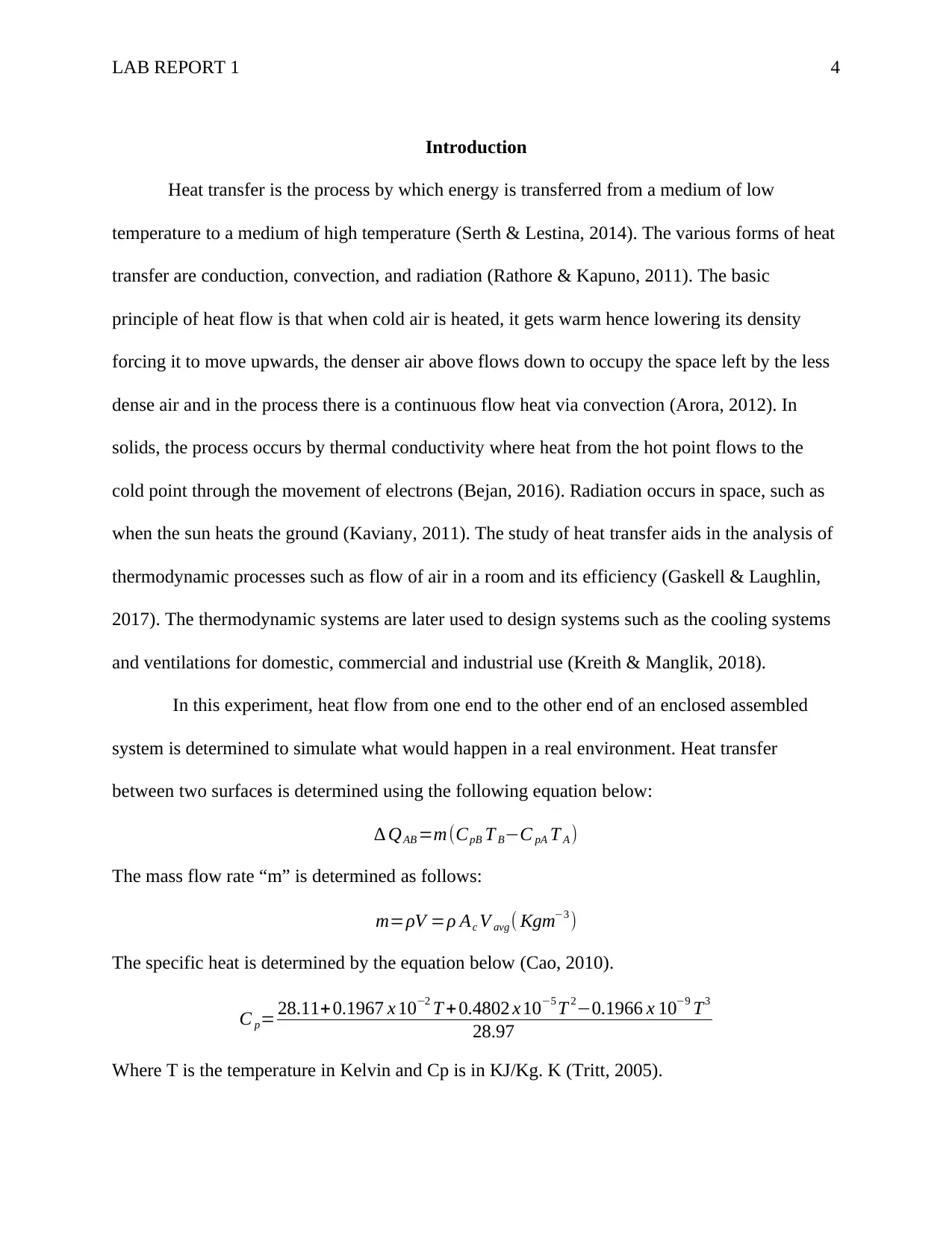
LAB REPORT 1 4
Introduction
Heat transfer is the process by which energy is transferred from a medium of low
temperature to a medium of high temperature (Serth & Lestina, 2014). The various forms of heat
transfer are conduction, convection, and radiation (Rathore & Kapuno, 2011). The basic
principle of heat flow is that when cold air is heated, it gets warm hence lowering its density
forcing it to move upwards, the denser air above flows down to occupy the space left by the less
dense air and in the process there is a continuous flow heat via convection (Arora, 2012). In
solids, the process occurs by thermal conductivity where heat from the hot point flows to the
cold point through the movement of electrons (Bejan, 2016). Radiation occurs in space, such as
when the sun heats the ground (Kaviany, 2011). The study of heat transfer aids in the analysis of
thermodynamic processes such as flow of air in a room and its efficiency (Gaskell & Laughlin,
2017). The thermodynamic systems are later used to design systems such as the cooling systems
and ventilations for domestic, commercial and industrial use (Kreith & Manglik, 2018).
In this experiment, heat flow from one end to the other end of an enclosed assembled
system is determined to simulate what would happen in a real environment. Heat transfer
between two surfaces is determined using the following equation below:
∆ QAB =m(CpB T B−C pA T A )
The mass flow rate “m” is determined as follows:
m=ρV =ρ Ac V avg ( Kgm−3 )
The specific heat is determined by the equation below (Cao, 2010).
C p= 28.11+0.1967 x 10−2 T + 0.4802 x 10−5 T 2−0.1966 x 10−9 T3
28.97
Where T is the temperature in Kelvin and Cp is in KJ/Kg. K (Tritt, 2005).
Introduction
Heat transfer is the process by which energy is transferred from a medium of low
temperature to a medium of high temperature (Serth & Lestina, 2014). The various forms of heat
transfer are conduction, convection, and radiation (Rathore & Kapuno, 2011). The basic
principle of heat flow is that when cold air is heated, it gets warm hence lowering its density
forcing it to move upwards, the denser air above flows down to occupy the space left by the less
dense air and in the process there is a continuous flow heat via convection (Arora, 2012). In
solids, the process occurs by thermal conductivity where heat from the hot point flows to the
cold point through the movement of electrons (Bejan, 2016). Radiation occurs in space, such as
when the sun heats the ground (Kaviany, 2011). The study of heat transfer aids in the analysis of
thermodynamic processes such as flow of air in a room and its efficiency (Gaskell & Laughlin,
2017). The thermodynamic systems are later used to design systems such as the cooling systems
and ventilations for domestic, commercial and industrial use (Kreith & Manglik, 2018).
In this experiment, heat flow from one end to the other end of an enclosed assembled
system is determined to simulate what would happen in a real environment. Heat transfer
between two surfaces is determined using the following equation below:
∆ QAB =m(CpB T B−C pA T A )
The mass flow rate “m” is determined as follows:
m=ρV =ρ Ac V avg ( Kgm−3 )
The specific heat is determined by the equation below (Cao, 2010).
C p= 28.11+0.1967 x 10−2 T + 0.4802 x 10−5 T 2−0.1966 x 10−9 T3
28.97
Where T is the temperature in Kelvin and Cp is in KJ/Kg. K (Tritt, 2005).
Paraphrase This Document
Need a fresh take? Get an instant paraphrase of this document with our AI Paraphraser
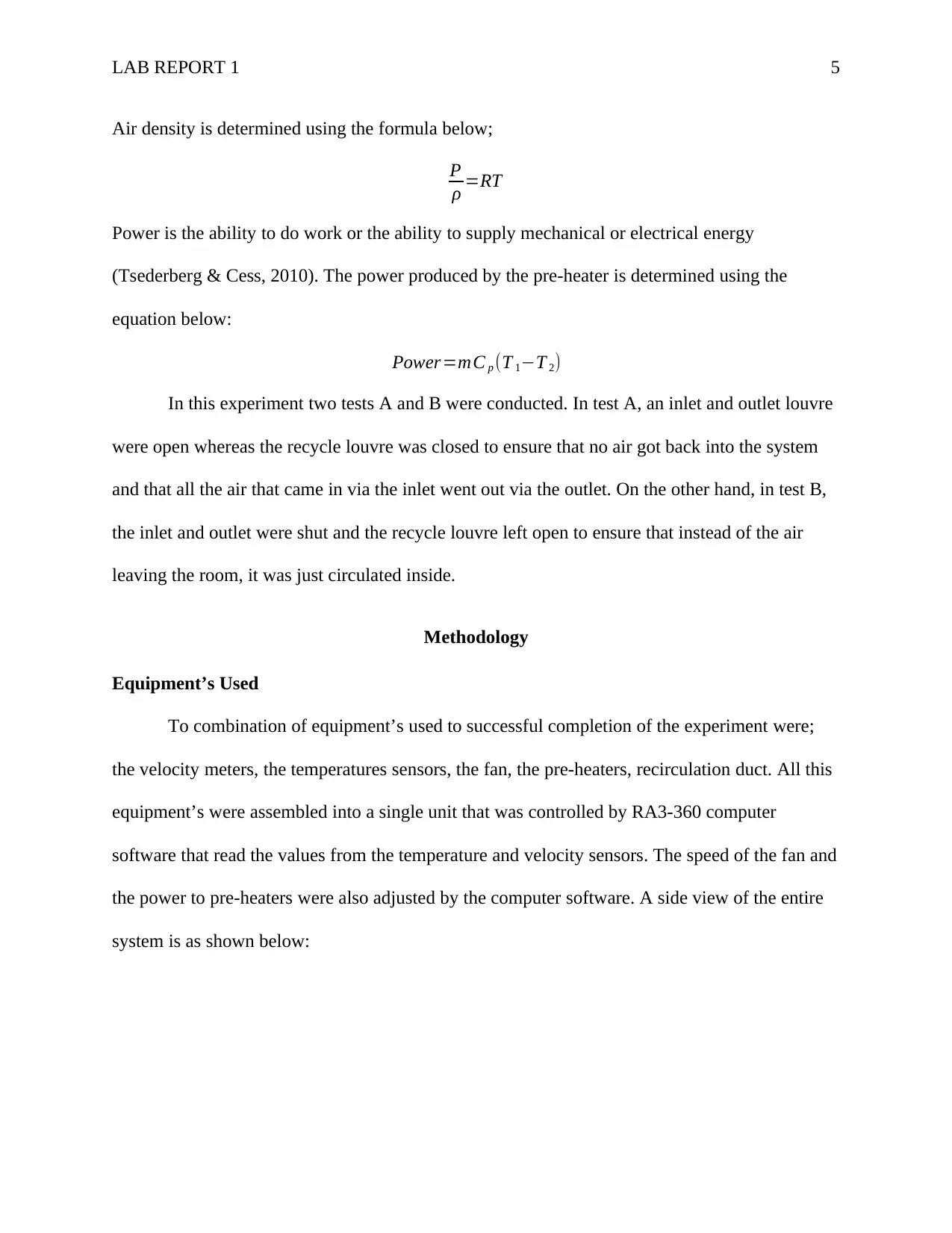
LAB REPORT 1 5
Air density is determined using the formula below;
P
ρ =RT
Power is the ability to do work or the ability to supply mechanical or electrical energy
(Tsederberg & Cess, 2010). The power produced by the pre-heater is determined using the
equation below:
Power=mC p (T 1−T 2)
In this experiment two tests A and B were conducted. In test A, an inlet and outlet louvre
were open whereas the recycle louvre was closed to ensure that no air got back into the system
and that all the air that came in via the inlet went out via the outlet. On the other hand, in test B,
the inlet and outlet were shut and the recycle louvre left open to ensure that instead of the air
leaving the room, it was just circulated inside.
Methodology
Equipment’s Used
To combination of equipment’s used to successful completion of the experiment were;
the velocity meters, the temperatures sensors, the fan, the pre-heaters, recirculation duct. All this
equipment’s were assembled into a single unit that was controlled by RA3-360 computer
software that read the values from the temperature and velocity sensors. The speed of the fan and
the power to pre-heaters were also adjusted by the computer software. A side view of the entire
system is as shown below:
Air density is determined using the formula below;
P
ρ =RT
Power is the ability to do work or the ability to supply mechanical or electrical energy
(Tsederberg & Cess, 2010). The power produced by the pre-heater is determined using the
equation below:
Power=mC p (T 1−T 2)
In this experiment two tests A and B were conducted. In test A, an inlet and outlet louvre
were open whereas the recycle louvre was closed to ensure that no air got back into the system
and that all the air that came in via the inlet went out via the outlet. On the other hand, in test B,
the inlet and outlet were shut and the recycle louvre left open to ensure that instead of the air
leaving the room, it was just circulated inside.
Methodology
Equipment’s Used
To combination of equipment’s used to successful completion of the experiment were;
the velocity meters, the temperatures sensors, the fan, the pre-heaters, recirculation duct. All this
equipment’s were assembled into a single unit that was controlled by RA3-360 computer
software that read the values from the temperature and velocity sensors. The speed of the fan and
the power to pre-heaters were also adjusted by the computer software. A side view of the entire
system is as shown below:

LAB REPORT 1 6
Figure 1: The Assembled Simulator System
Air will flow from the inlet to the outlet for test A, and as it flows it will first be filtered
to ensure only clean air gets in. Then it will be heated at instances to compensate for the heat lost
as it flows form the inlet to the out let. Temperatures placed strategically within the system will
measure the temperature. Moreover, the velocity of the air getting in and out of the system will
be determined by use of velocity meters placed near the inlet and the outlet. In test B, the inlets
and the outlets will be closed and only the recycle louvre will be operational. Again, the
temperatures and the velocity will be determined and recorded on the computer software.
Experimental Set-up
Figure 2: Sectional View of the Simulator
The equipment above was used for simulation purpose. Air got into the system via the
inlet louver through a transparent duct. The transparency of the duct facilitated visibility. A
Figure 1: The Assembled Simulator System
Air will flow from the inlet to the outlet for test A, and as it flows it will first be filtered
to ensure only clean air gets in. Then it will be heated at instances to compensate for the heat lost
as it flows form the inlet to the out let. Temperatures placed strategically within the system will
measure the temperature. Moreover, the velocity of the air getting in and out of the system will
be determined by use of velocity meters placed near the inlet and the outlet. In test B, the inlets
and the outlets will be closed and only the recycle louvre will be operational. Again, the
temperatures and the velocity will be determined and recorded on the computer software.
Experimental Set-up
Figure 2: Sectional View of the Simulator
The equipment above was used for simulation purpose. Air got into the system via the
inlet louver through a transparent duct. The transparency of the duct facilitated visibility. A
⊘ This is a preview!⊘
Do you want full access?
Subscribe today to unlock all pages.

Trusted by 1+ million students worldwide

LAB REPORT 1 7
controller on the surface of the system was used to control the opening and closing of the system
for air flow. Other components in the system were; computer controlled pre-heaters to heat the
inlet air set at 40% and 60%, a computer controlled fan of fixed speed, temperature sensor for
measurement of temperature getting in and out of the duct and filters to ensure that only clean air
got into the system.
The temperature sensors were placed at specified distances along the system.
Temperature sensor T1 was placed at the inlet, while T2 was placed on the other end of the duct
after the first set of preheaters to measure the temperature in the pipe. Due to the presence of the
preheaters, the temperature T2 was greater than T1. After T2 another temperature sensor T3
existed to measure before it got into the room. Again, preheaters were used to heat air between
T2 and T3 so as to compensate for the heat lost as the air travelled through the duct. Temperature
sensor T4 measured the temperature just before it exited into the room and temperature sensor
T5 measured the temperature from the room. Temperature T5 was less than T4 since the warm
air from T4 had lost some of its energy before it got into the room.
Two velocity sensors V1 and V2 were installed at the inlet and the outlet of the system to
measure the velocity of the incoming and outgoing air. Recycle louvre was installed at the inlet
to allow reentry of air into the system from the external environment. The whole system was
connected to a computer via the RA3-306 Air condition software.
Assumptions
Assumptions were made to ensure efficiency of the system and hence the accuracy of the
results were of high quality and reliable. The assumptions were; the flow of air was uniform
throughout the system, temperature was equally distributed in the system, the air in the
controller on the surface of the system was used to control the opening and closing of the system
for air flow. Other components in the system were; computer controlled pre-heaters to heat the
inlet air set at 40% and 60%, a computer controlled fan of fixed speed, temperature sensor for
measurement of temperature getting in and out of the duct and filters to ensure that only clean air
got into the system.
The temperature sensors were placed at specified distances along the system.
Temperature sensor T1 was placed at the inlet, while T2 was placed on the other end of the duct
after the first set of preheaters to measure the temperature in the pipe. Due to the presence of the
preheaters, the temperature T2 was greater than T1. After T2 another temperature sensor T3
existed to measure before it got into the room. Again, preheaters were used to heat air between
T2 and T3 so as to compensate for the heat lost as the air travelled through the duct. Temperature
sensor T4 measured the temperature just before it exited into the room and temperature sensor
T5 measured the temperature from the room. Temperature T5 was less than T4 since the warm
air from T4 had lost some of its energy before it got into the room.
Two velocity sensors V1 and V2 were installed at the inlet and the outlet of the system to
measure the velocity of the incoming and outgoing air. Recycle louvre was installed at the inlet
to allow reentry of air into the system from the external environment. The whole system was
connected to a computer via the RA3-306 Air condition software.
Assumptions
Assumptions were made to ensure efficiency of the system and hence the accuracy of the
results were of high quality and reliable. The assumptions were; the flow of air was uniform
throughout the system, temperature was equally distributed in the system, the air in the
Paraphrase This Document
Need a fresh take? Get an instant paraphrase of this document with our AI Paraphraser
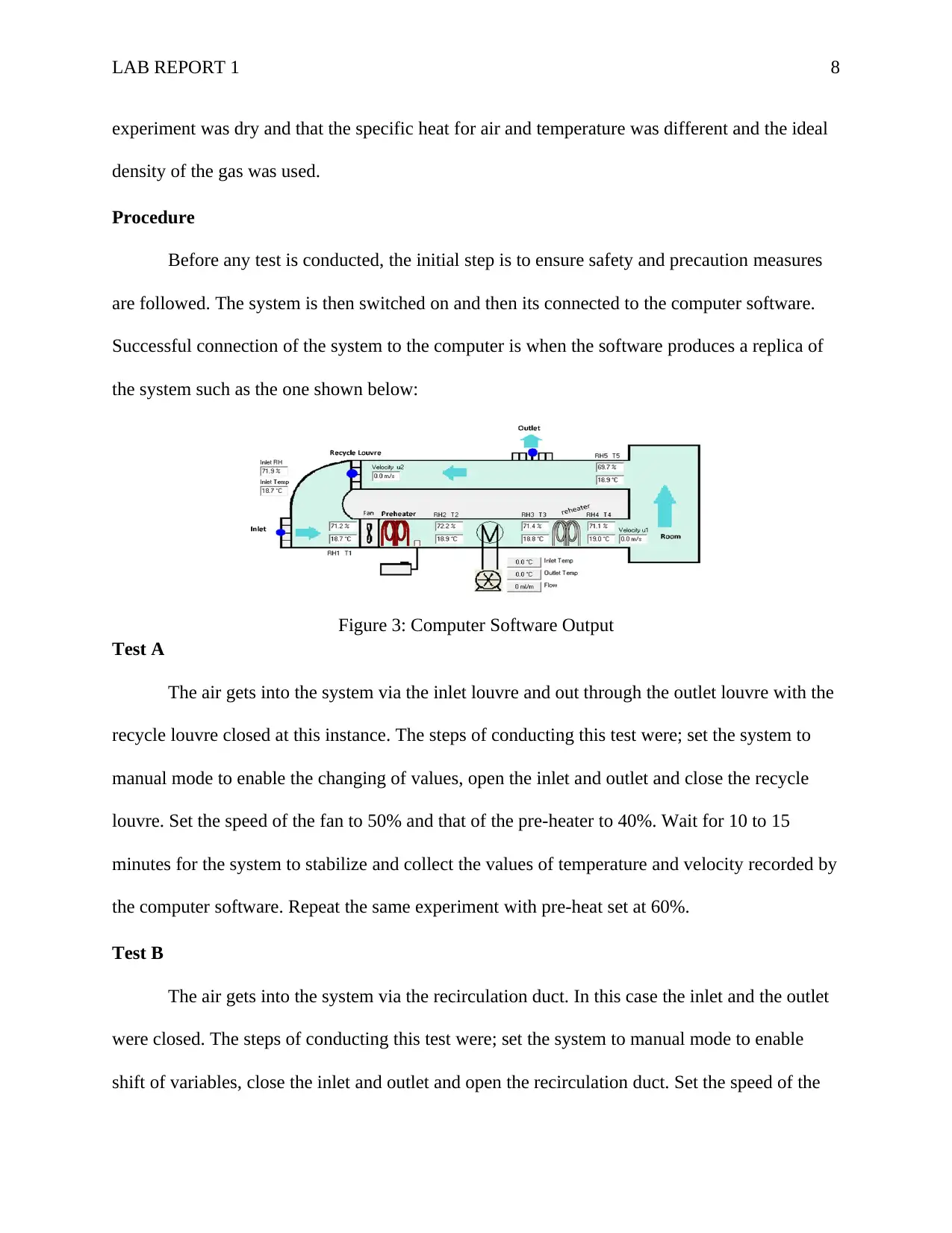
LAB REPORT 1 8
experiment was dry and that the specific heat for air and temperature was different and the ideal
density of the gas was used.
Procedure
Before any test is conducted, the initial step is to ensure safety and precaution measures
are followed. The system is then switched on and then its connected to the computer software.
Successful connection of the system to the computer is when the software produces a replica of
the system such as the one shown below:
Figure 3: Computer Software Output
Test A
The air gets into the system via the inlet louvre and out through the outlet louvre with the
recycle louvre closed at this instance. The steps of conducting this test were; set the system to
manual mode to enable the changing of values, open the inlet and outlet and close the recycle
louvre. Set the speed of the fan to 50% and that of the pre-heater to 40%. Wait for 10 to 15
minutes for the system to stabilize and collect the values of temperature and velocity recorded by
the computer software. Repeat the same experiment with pre-heat set at 60%.
Test B
The air gets into the system via the recirculation duct. In this case the inlet and the outlet
were closed. The steps of conducting this test were; set the system to manual mode to enable
shift of variables, close the inlet and outlet and open the recirculation duct. Set the speed of the
experiment was dry and that the specific heat for air and temperature was different and the ideal
density of the gas was used.
Procedure
Before any test is conducted, the initial step is to ensure safety and precaution measures
are followed. The system is then switched on and then its connected to the computer software.
Successful connection of the system to the computer is when the software produces a replica of
the system such as the one shown below:
Figure 3: Computer Software Output
Test A
The air gets into the system via the inlet louvre and out through the outlet louvre with the
recycle louvre closed at this instance. The steps of conducting this test were; set the system to
manual mode to enable the changing of values, open the inlet and outlet and close the recycle
louvre. Set the speed of the fan to 50% and that of the pre-heater to 40%. Wait for 10 to 15
minutes for the system to stabilize and collect the values of temperature and velocity recorded by
the computer software. Repeat the same experiment with pre-heat set at 60%.
Test B
The air gets into the system via the recirculation duct. In this case the inlet and the outlet
were closed. The steps of conducting this test were; set the system to manual mode to enable
shift of variables, close the inlet and outlet and open the recirculation duct. Set the speed of the

LAB REPORT 1 9
fan to 50% and that of the pre-heater to 40%. Wait for 10 to 15 minutes for the system to
stabilize and collect the values of temperature and velocity recorded by the computer software.
Repeat the same experiment with pre-heat set at 60%.
Results and Analysis
The results obtained for both test A and B were recorded in the table below:
Table 1: Results
The heat loss between T2 and T4 in test A1 is determined as below;
∆ Q24 =m(Cp 4 T 4 −Cp 2 T2 )
But m is given by,
m=ρV =ρ Ac V avg ( Kgs−1)
And
P
RT =ρ= 101325
287 X 302=1.16 Kgm−3
Hence,
m=ρV =ρ Ac V avg ( Kgs−1 ) =1.16 X 0.9 x 0.04=0.041 Kgs−1
The specific heat is the same for all the temperatures and is calculated using the following;
C p= 28.11+0.1967 x 10−2 (302)+0.4802 x 10−5 (302)2−0.1966 x 10−9 (302)3
28.97
¿ 29.41
28.29 =1.00 KJ per Kg∗K
The value of heat loss between T2 and T4 is thus determined as follows:
fan to 50% and that of the pre-heater to 40%. Wait for 10 to 15 minutes for the system to
stabilize and collect the values of temperature and velocity recorded by the computer software.
Repeat the same experiment with pre-heat set at 60%.
Results and Analysis
The results obtained for both test A and B were recorded in the table below:
Table 1: Results
The heat loss between T2 and T4 in test A1 is determined as below;
∆ Q24 =m(Cp 4 T 4 −Cp 2 T2 )
But m is given by,
m=ρV =ρ Ac V avg ( Kgs−1)
And
P
RT =ρ= 101325
287 X 302=1.16 Kgm−3
Hence,
m=ρV =ρ Ac V avg ( Kgs−1 ) =1.16 X 0.9 x 0.04=0.041 Kgs−1
The specific heat is the same for all the temperatures and is calculated using the following;
C p= 28.11+0.1967 x 10−2 (302)+0.4802 x 10−5 (302)2−0.1966 x 10−9 (302)3
28.97
¿ 29.41
28.29 =1.00 KJ per Kg∗K
The value of heat loss between T2 and T4 is thus determined as follows:
⊘ This is a preview!⊘
Do you want full access?
Subscribe today to unlock all pages.

Trusted by 1+ million students worldwide
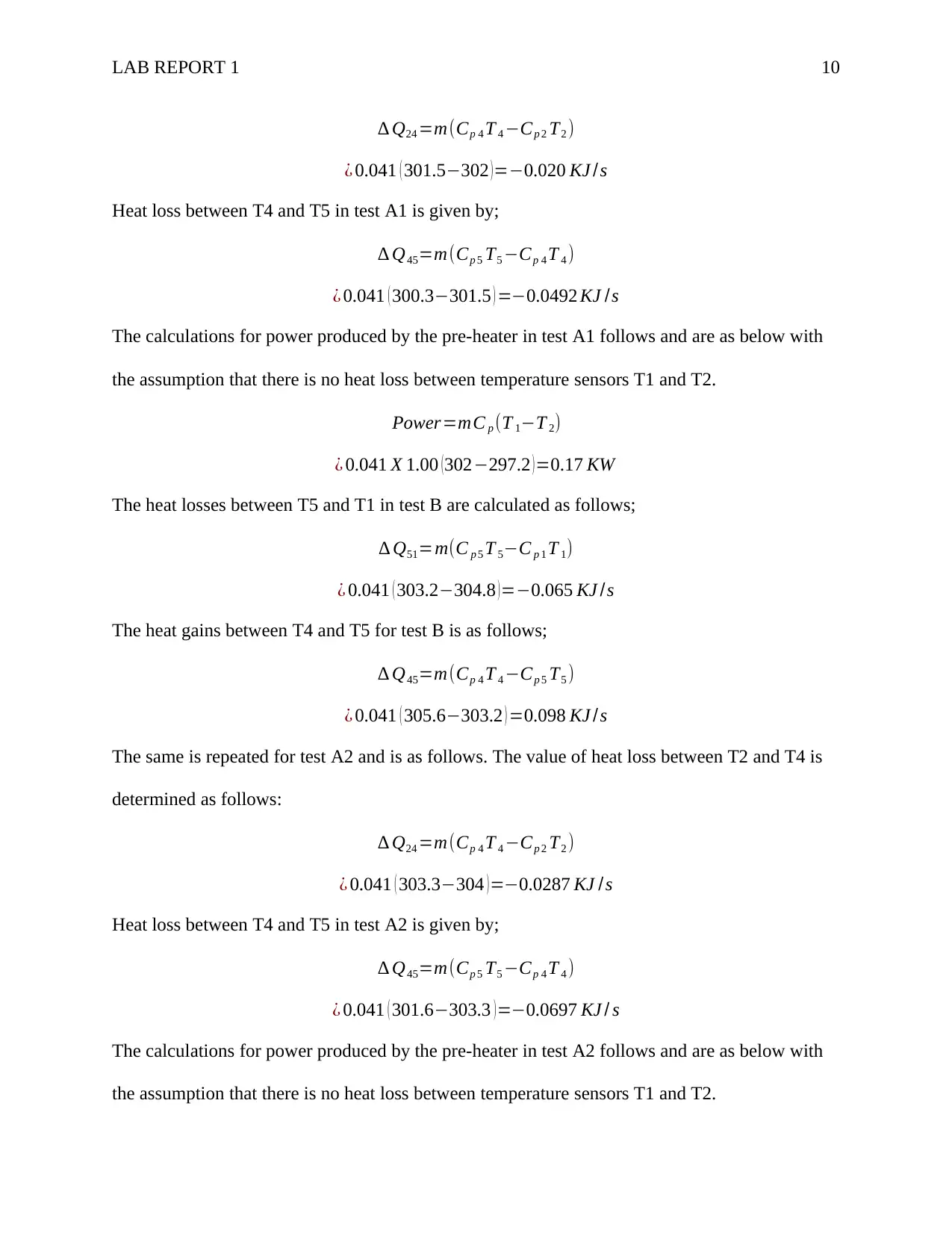
LAB REPORT 1 10
∆ Q24 =m(Cp 4 T 4 −Cp 2 T2 )
¿ 0.041 ( 301.5−302 )=−0.020 KJ /s
Heat loss between T4 and T5 in test A1 is given by;
∆ Q45=m(Cp 5 T5 −Cp 4 T 4 )
¿ 0.041 ( 300.3−301.5 ) =−0.0492 KJ /s
The calculations for power produced by the pre-heater in test A1 follows and are as below with
the assumption that there is no heat loss between temperature sensors T1 and T2.
Power=mC p (T 1−T 2)
¿ 0.041 X 1.00 (302−297.2 )=0.17 KW
The heat losses between T5 and T1 in test B are calculated as follows;
∆ Q51=m(C p 5 T 5−C p 1 T 1)
¿ 0.041 ( 303.2−304.8 )=−0.065 KJ /s
The heat gains between T4 and T5 for test B is as follows;
∆ Q45=m(Cp 4 T 4 −Cp 5 T5 )
¿ 0.041 ( 305.6−303.2 ) =0.098 KJ /s
The same is repeated for test A2 and is as follows. The value of heat loss between T2 and T4 is
determined as follows:
∆ Q24 =m(Cp 4 T 4 −Cp 2 T2 )
¿ 0.041 ( 303.3−304 ) =−0.0287 KJ /s
Heat loss between T4 and T5 in test A2 is given by;
∆ Q45=m(Cp 5 T5 −Cp 4 T 4 )
¿ 0.041 ( 301.6−303.3 )=−0.0697 KJ / s
The calculations for power produced by the pre-heater in test A2 follows and are as below with
the assumption that there is no heat loss between temperature sensors T1 and T2.
∆ Q24 =m(Cp 4 T 4 −Cp 2 T2 )
¿ 0.041 ( 301.5−302 )=−0.020 KJ /s
Heat loss between T4 and T5 in test A1 is given by;
∆ Q45=m(Cp 5 T5 −Cp 4 T 4 )
¿ 0.041 ( 300.3−301.5 ) =−0.0492 KJ /s
The calculations for power produced by the pre-heater in test A1 follows and are as below with
the assumption that there is no heat loss between temperature sensors T1 and T2.
Power=mC p (T 1−T 2)
¿ 0.041 X 1.00 (302−297.2 )=0.17 KW
The heat losses between T5 and T1 in test B are calculated as follows;
∆ Q51=m(C p 5 T 5−C p 1 T 1)
¿ 0.041 ( 303.2−304.8 )=−0.065 KJ /s
The heat gains between T4 and T5 for test B is as follows;
∆ Q45=m(Cp 4 T 4 −Cp 5 T5 )
¿ 0.041 ( 305.6−303.2 ) =0.098 KJ /s
The same is repeated for test A2 and is as follows. The value of heat loss between T2 and T4 is
determined as follows:
∆ Q24 =m(Cp 4 T 4 −Cp 2 T2 )
¿ 0.041 ( 303.3−304 ) =−0.0287 KJ /s
Heat loss between T4 and T5 in test A2 is given by;
∆ Q45=m(Cp 5 T5 −Cp 4 T 4 )
¿ 0.041 ( 301.6−303.3 )=−0.0697 KJ / s
The calculations for power produced by the pre-heater in test A2 follows and are as below with
the assumption that there is no heat loss between temperature sensors T1 and T2.
Paraphrase This Document
Need a fresh take? Get an instant paraphrase of this document with our AI Paraphraser
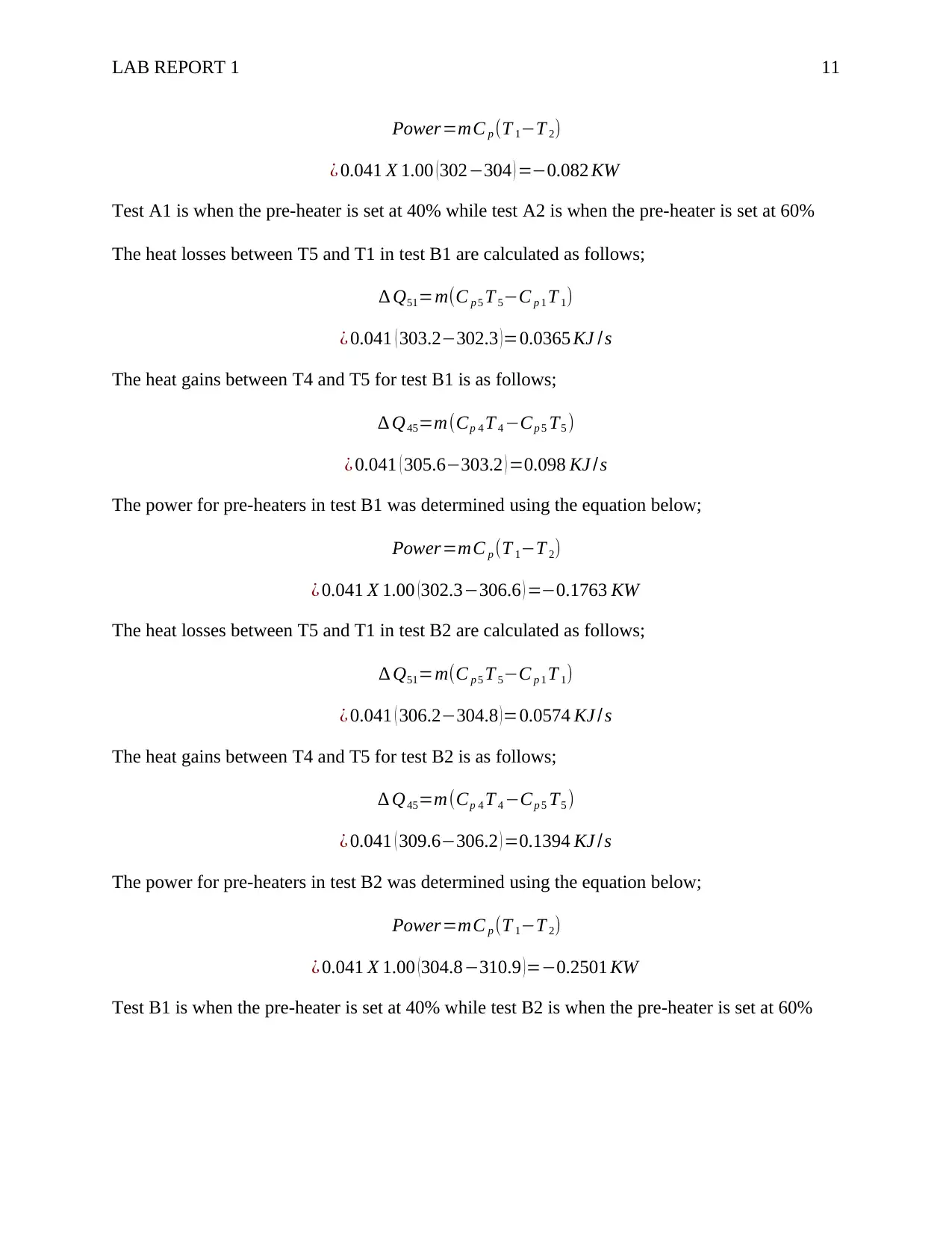
LAB REPORT 1 11
Power=mC p (T 1−T 2)
¿ 0.041 X 1.00 (302−304 ) =−0.082 KW
Test A1 is when the pre-heater is set at 40% while test A2 is when the pre-heater is set at 60%
The heat losses between T5 and T1 in test B1 are calculated as follows;
∆ Q51=m(C p 5 T 5−C p 1 T 1)
¿ 0.041 ( 303.2−302.3 )=0.0365 KJ /s
The heat gains between T4 and T5 for test B1 is as follows;
∆ Q45=m(Cp 4 T 4 −Cp 5 T5 )
¿ 0.041 ( 305.6−303.2 ) =0.098 KJ /s
The power for pre-heaters in test B1 was determined using the equation below;
Power=mC p (T 1−T 2)
¿ 0.041 X 1.00 (302.3−306.6 ) =−0.1763 KW
The heat losses between T5 and T1 in test B2 are calculated as follows;
∆ Q51=m(C p 5 T 5−C p 1 T 1)
¿ 0.041 ( 306.2−304.8 ) =0.0574 KJ / s
The heat gains between T4 and T5 for test B2 is as follows;
∆ Q45=m(Cp 4 T 4 −Cp 5 T5 )
¿ 0.041 ( 309.6−306.2 ) =0.1394 KJ /s
The power for pre-heaters in test B2 was determined using the equation below;
Power=mC p (T 1−T 2)
¿ 0.041 X 1.00 ( 304.8−310.9 ) =−0.2501 KW
Test B1 is when the pre-heater is set at 40% while test B2 is when the pre-heater is set at 60%
Power=mC p (T 1−T 2)
¿ 0.041 X 1.00 (302−304 ) =−0.082 KW
Test A1 is when the pre-heater is set at 40% while test A2 is when the pre-heater is set at 60%
The heat losses between T5 and T1 in test B1 are calculated as follows;
∆ Q51=m(C p 5 T 5−C p 1 T 1)
¿ 0.041 ( 303.2−302.3 )=0.0365 KJ /s
The heat gains between T4 and T5 for test B1 is as follows;
∆ Q45=m(Cp 4 T 4 −Cp 5 T5 )
¿ 0.041 ( 305.6−303.2 ) =0.098 KJ /s
The power for pre-heaters in test B1 was determined using the equation below;
Power=mC p (T 1−T 2)
¿ 0.041 X 1.00 (302.3−306.6 ) =−0.1763 KW
The heat losses between T5 and T1 in test B2 are calculated as follows;
∆ Q51=m(C p 5 T 5−C p 1 T 1)
¿ 0.041 ( 306.2−304.8 ) =0.0574 KJ / s
The heat gains between T4 and T5 for test B2 is as follows;
∆ Q45=m(Cp 4 T 4 −Cp 5 T5 )
¿ 0.041 ( 309.6−306.2 ) =0.1394 KJ /s
The power for pre-heaters in test B2 was determined using the equation below;
Power=mC p (T 1−T 2)
¿ 0.041 X 1.00 ( 304.8−310.9 ) =−0.2501 KW
Test B1 is when the pre-heater is set at 40% while test B2 is when the pre-heater is set at 60%
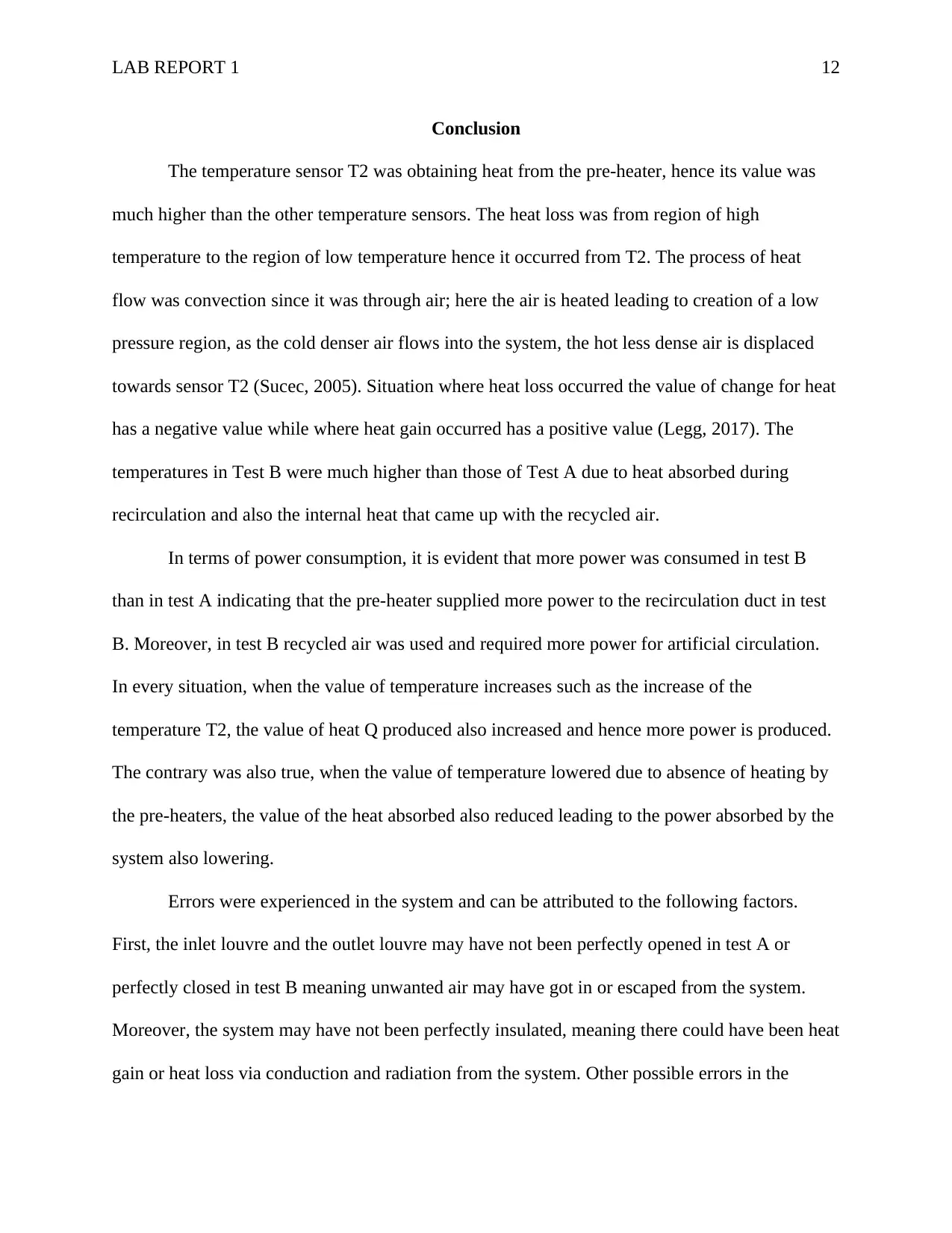
LAB REPORT 1 12
Conclusion
The temperature sensor T2 was obtaining heat from the pre-heater, hence its value was
much higher than the other temperature sensors. The heat loss was from region of high
temperature to the region of low temperature hence it occurred from T2. The process of heat
flow was convection since it was through air; here the air is heated leading to creation of a low
pressure region, as the cold denser air flows into the system, the hot less dense air is displaced
towards sensor T2 (Sucec, 2005). Situation where heat loss occurred the value of change for heat
has a negative value while where heat gain occurred has a positive value (Legg, 2017). The
temperatures in Test B were much higher than those of Test A due to heat absorbed during
recirculation and also the internal heat that came up with the recycled air.
In terms of power consumption, it is evident that more power was consumed in test B
than in test A indicating that the pre-heater supplied more power to the recirculation duct in test
B. Moreover, in test B recycled air was used and required more power for artificial circulation.
In every situation, when the value of temperature increases such as the increase of the
temperature T2, the value of heat Q produced also increased and hence more power is produced.
The contrary was also true, when the value of temperature lowered due to absence of heating by
the pre-heaters, the value of the heat absorbed also reduced leading to the power absorbed by the
system also lowering.
Errors were experienced in the system and can be attributed to the following factors.
First, the inlet louvre and the outlet louvre may have not been perfectly opened in test A or
perfectly closed in test B meaning unwanted air may have got in or escaped from the system.
Moreover, the system may have not been perfectly insulated, meaning there could have been heat
gain or heat loss via conduction and radiation from the system. Other possible errors in the
Conclusion
The temperature sensor T2 was obtaining heat from the pre-heater, hence its value was
much higher than the other temperature sensors. The heat loss was from region of high
temperature to the region of low temperature hence it occurred from T2. The process of heat
flow was convection since it was through air; here the air is heated leading to creation of a low
pressure region, as the cold denser air flows into the system, the hot less dense air is displaced
towards sensor T2 (Sucec, 2005). Situation where heat loss occurred the value of change for heat
has a negative value while where heat gain occurred has a positive value (Legg, 2017). The
temperatures in Test B were much higher than those of Test A due to heat absorbed during
recirculation and also the internal heat that came up with the recycled air.
In terms of power consumption, it is evident that more power was consumed in test B
than in test A indicating that the pre-heater supplied more power to the recirculation duct in test
B. Moreover, in test B recycled air was used and required more power for artificial circulation.
In every situation, when the value of temperature increases such as the increase of the
temperature T2, the value of heat Q produced also increased and hence more power is produced.
The contrary was also true, when the value of temperature lowered due to absence of heating by
the pre-heaters, the value of the heat absorbed also reduced leading to the power absorbed by the
system also lowering.
Errors were experienced in the system and can be attributed to the following factors.
First, the inlet louvre and the outlet louvre may have not been perfectly opened in test A or
perfectly closed in test B meaning unwanted air may have got in or escaped from the system.
Moreover, the system may have not been perfectly insulated, meaning there could have been heat
gain or heat loss via conduction and radiation from the system. Other possible errors in the
⊘ This is a preview!⊘
Do you want full access?
Subscribe today to unlock all pages.

Trusted by 1+ million students worldwide
1 out of 14
Related Documents
Your All-in-One AI-Powered Toolkit for Academic Success.
+13062052269
info@desklib.com
Available 24*7 on WhatsApp / Email
![[object Object]](/_next/static/media/star-bottom.7253800d.svg)
Unlock your academic potential
Copyright © 2020–2025 A2Z Services. All Rights Reserved. Developed and managed by ZUCOL.





